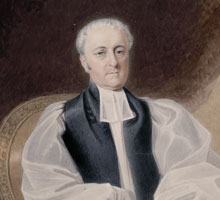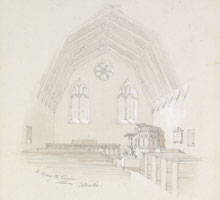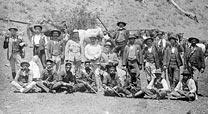Family life
Life on the land often provided pastoralists with leisure time and an elegant lifestyle. This played an important part in enticing immigrants who were attracted to the idea of an affluent and gracious way of life in the colony.
George Townshend and the Boydell brothers all made successful colonial marriages, and there were plenty of agreeable colonial 'gentry' who settled in and around the Allyn River district. This provided plenty of social activity.
35-year-old George Townshend was the first to wed. He married 18-year-old Elizabeth Bottrell Manning (1815-1888) at St James' Church, Sydney, on 18 June 1833. A daughter of John Edye Manning, Elizabeth had arrived in Australia with her family in 1829. Three days before the wedding, as per the custom of the day, Townshend had made Trevallyn over to his future wife. Charles Boydell attended the nuptials, noting in his diary that it 'went off as things of that kind usually do - dully enough...'
It's clear from Charles Boydell's journal that, during the years spent setting up Camyr Allyn, he spent some effort searching for a wife from within his own social class. While it is not known how he finally met and wooed his bride, he had stated his intention to marry a colonial girl:
'Men [ ] talking of going to England for a wife would that not be a libel upon the female of our adopted country: where so many...fitting for all societies are daily maturing…..anyone who has known the happiness of a large family would prefer connecting himself here with a family of respectability whose society he might cultivate and would be the cause of making his spouse more content: I often think a person must make use of a little deceit before he can prevail upon a body to renounce all her family & friends for him alone & to give up the company and luxuries she has been accustomed to for the hardships & privations of a settler's life.'
Journal, 1830-1835, by Charles Boydell Manuscript A 2014
On 2 May 1837, Charles Boydell and Elizabeth Macdonald Ritchie (1817-1899) were married by Bishop Broughton at St James' Church, Sydney. Elizabeth Ritchie was very well connected socially; she was the daughter of Harriott Mary Dowling (nee Ritchie), step-daughter of Sir James Dowling, the Chief Justice, and a grand-daughter of John Blaxland of Newington.
William Boydell met his future bride on the voyage out to the colony in 1836. Mary Phoebe Broughton (1820-1867) was the elder daughter of William Grant Broughton, the recently consecrated Bishop of Australia, who was returning to Sydney with his family. What began as a shipboard friendship between two teenagers, became an eight year and often long distance relationship which culminated in a private wedding ceremony at St James' Church, Sydney, on 18 April 1844.
After the Governor and the Chief Justice, the Bishop of Australia was third in the order of colonial precedence. As such, the Broughton's could be forgiven for their hesitation in granting permission for their daughter to marry a Welsh farmer living on the fringe of the settled area. To assess the kind of life Mary would know in County Durham, the Broughton family paid a visit to the district, staying at Trevallyn and Camyr Allyn, in January 1840.
Throughout the years it took William Boydell to establish Caergwrle homestead, the young couple proved their steadfast affection. With the seal of approval given to the district, the building of a church and burial ground on the property was the final condition to the Bishop's granting permission for the marriage. On April 12, 1844, just four days before their wedding at St James' Church, Sydney, William Boydell transferred one acre of land to the Bishop of Australia. Broughton took a personal interest in the design and construction of the Church of St Mary the Virgin on Allyn, which was consecrated by him on 26 November 1845.
Above left: Detail from William Grant Broughton, Bishop of Australia, 1843, by W. Nicholas, Watercolour
Above right: Detail from Interior, St Mary the Virgin, Allyn River, 1856, by J. A. C. Willis, Pencil sketch
Three months after the Broughtons' visit to County Durham, the Townshend family was increased by the birth of third (& second surviving) daughter, Emily, on May 17 1840. Meanwhile, at Camyr Allyn, Elizabeth Boydell had given birth to her second child on 20 April 1840, a daughter named Harriett Mary. Mary Phoebe Boydell's first daughter, Sarah, was born on 10 April 1845 and, in the years to come, there would be 23 children born into these three families.
The company of near neighbours and good friends would have improved the quality of life of all family members. Women living on rural properties often lacked the support of other adult females. Visits to town, and from friends and relatives passing through the district, local parish life and the social round of neighbourhood calls helped ease this isolation.







